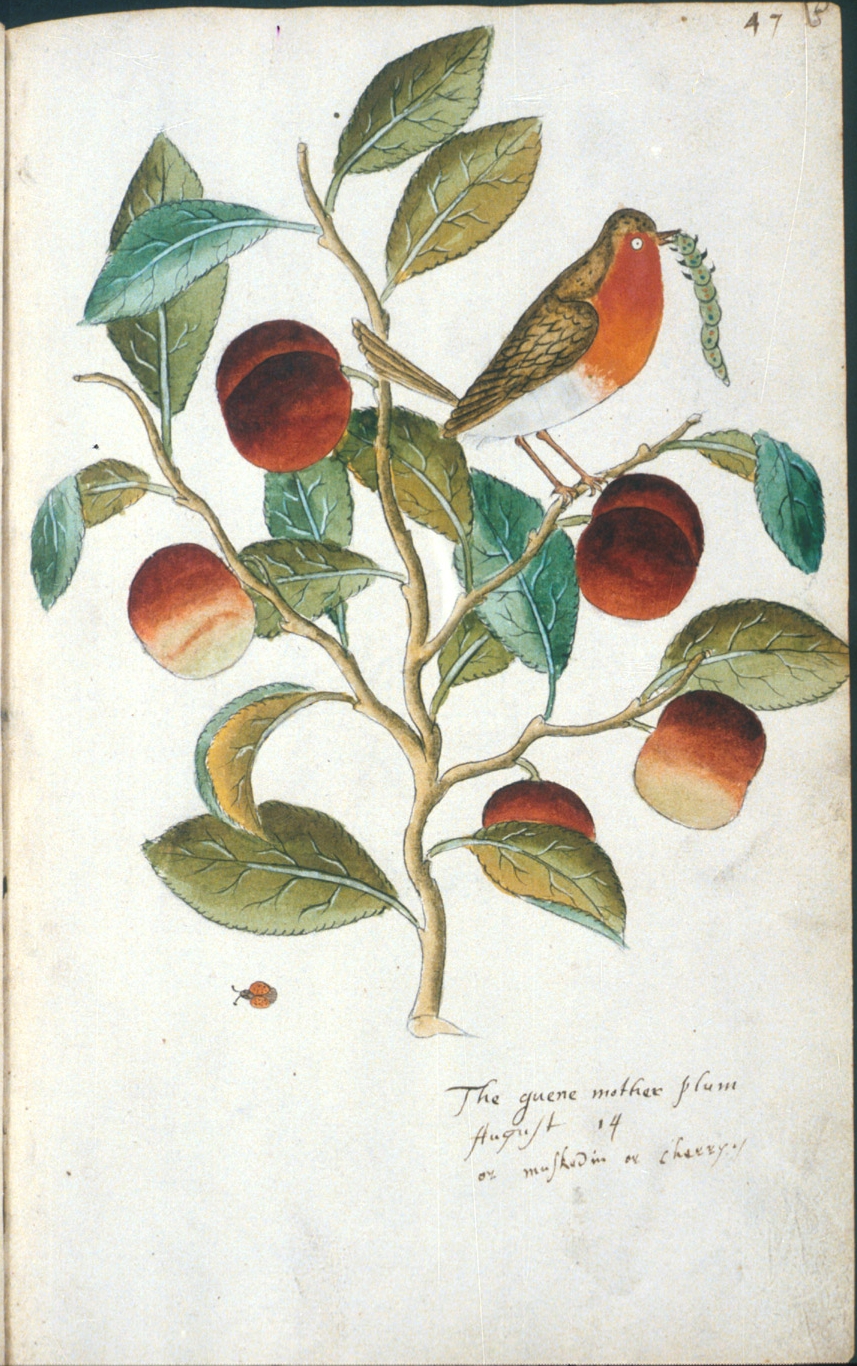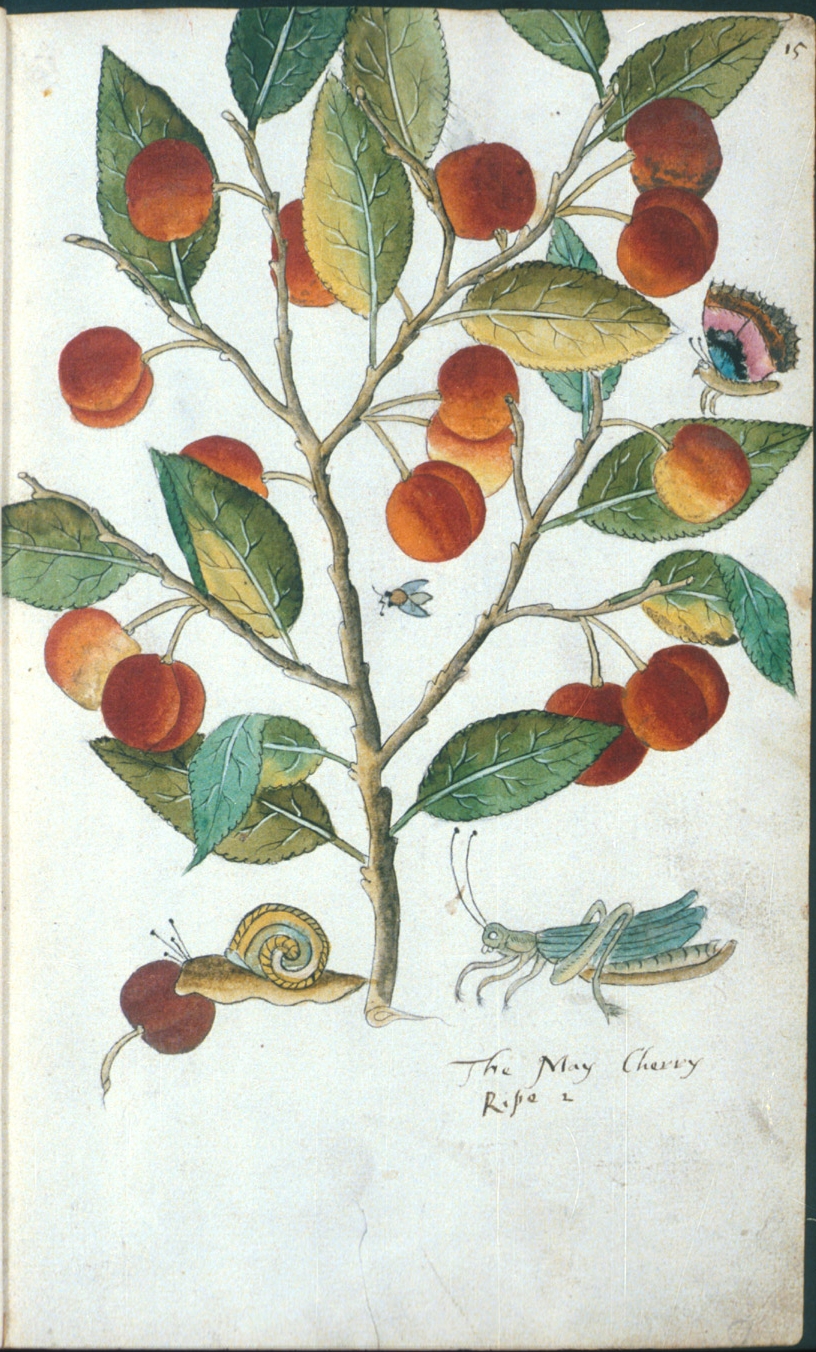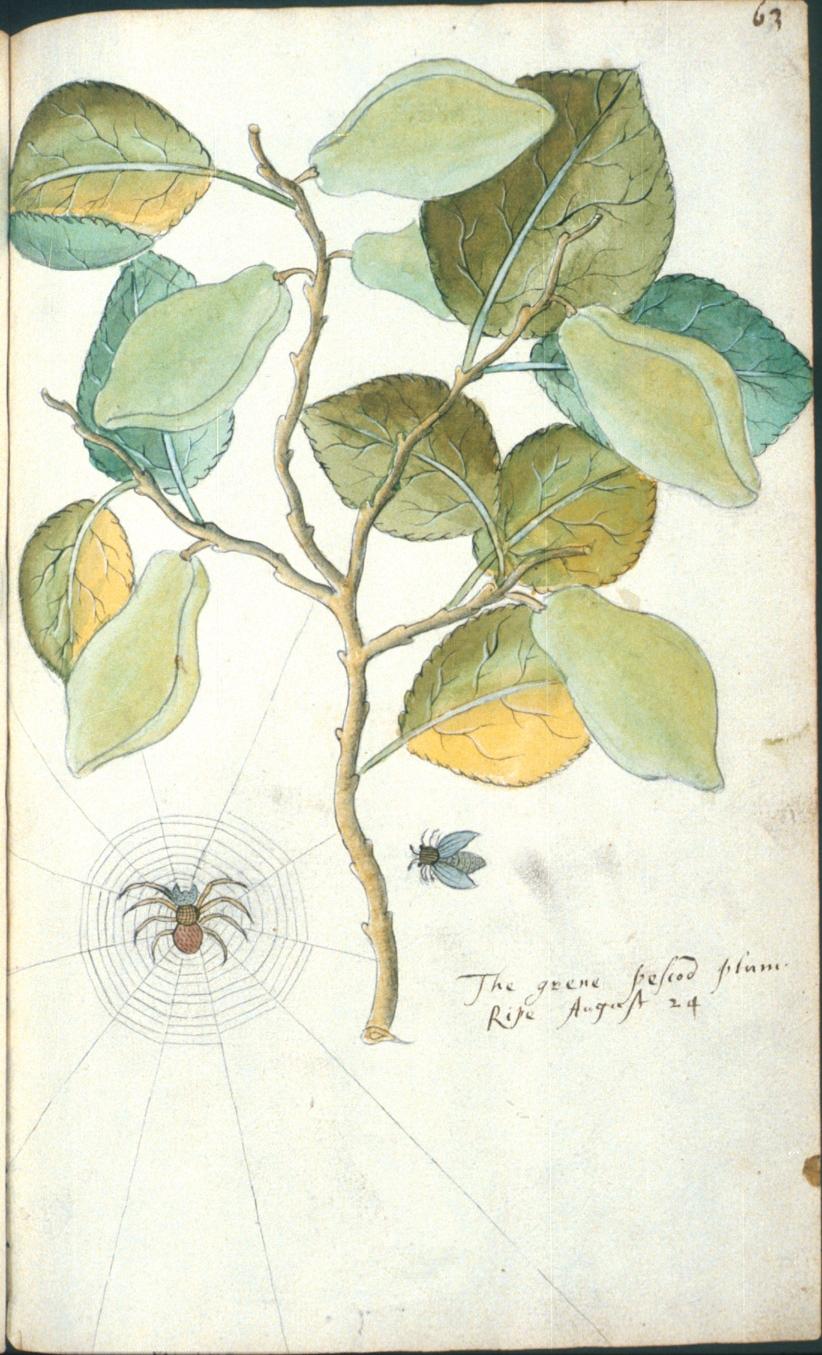'The Red pescod plum'

'An Early ripe Apple and good in taste'

'The whighte peech'

'The yollow Nectrion'

'The Nuingetonn peeche'

'The portingegale Quince'

'The quene mother plum'

'The whight Date'

'The grete \Early/ yollow peech'

'The grete Roman Hasell Nut'

'The Imperyall plum'

'The May Cherry'

'The Mussule plum'

'The Apricooke (that is booth Long and greet)'

'The frier plum'**

'the great French stra(w)bere'

'The grene pescod plum'
John Tradescant (~1570-1632) and his son, also named John (1608-1662), were gardeners to the nobility and royalty of England and both travelled widely collecting botanical specimens. Between them they introduced a large number of foreign species (including many of the fruits depicted) that remain prevalent in the average English gardens of today.
Their exotic tendencies manifested themselves most influentially at the estate begun by John Snr in the borough of Lambeth on the Thames river, near London. In addition to the more than 700 species of plants growing in the garden and orchard, the house itself (known as Tradescant's Ark) was a veritable cabinet of curiosities, where John Snr and later, John Jnr, displayed the many novel items they each had collected during their foreign travels.
Tradescant's Ark is regarded as the first English museum and people were happy to pay an entrance fee to see not only the 'regular' inventory of coins, weapons, stuffed animals, peculiar foreign garments and the like, but were also treated with a glimpse of the more fanciful: a section of Christ's cross and the hand of a mermaid, among other things. In 1656, John Jnr published a catalogue called 'Musaeum Tradescantianum', which recorded in detail the contents of the house and garden.
It was probably around 1650 when John Jnr became acquaintanced with the antiquary, politician and alchemist, Elias Ashmole. Ashmole was intensely interested in the Ark's contents and probably agitated for its itemisation for the 1656 book that Ashmole himself funded.
From reading around online, I'm not completely convinced as to the true circumstances that followed, during John Jnr's later years. Certainly Ashmole had John Jnr sign a bequesting authority that would allow Ashmole to inherit the museum's contents upon the death of John Jnr's wife. There had been discussions about the collection going to a University. However, after John Jnr died , a court case with Hester Tradescant (wife) ensued in which Ashmole was awarded control of the collection and, either ironically or conveniently, Hester was found drowned at the Lambeth estate in 1682 by Ashmole's wife (Ashmole had moved in next door to Tradescant by this stage). The whole affair is coloured by intrigue, psychological shenanigans and, no doubt, a healthy slice of greed and ego.
Subsequently, the collection (including the fruit sketches) was donated to Oxford University, thereby establishing the now very famous Ashmolean Museum. It is said that Ashmole, at least initially, passed off the collection as his own. It is also said that Ashmole was an energetic curio collector himself, but it seems certain the vast majority of the gift to the university was from the Tradescant Ark. I wonder if a name change has ever been canvassed for the museum? The overall arguments range of course from Ashmole being a magnanimous cultural benefactor who ensured the lasting fame of the Tradescants to his being nothing more than a conniving vulture &c. Methinks I want to read the books. There is a LOT more of interest about the lives of these fascinating gardener-collectors that I've not even hinted at really.
The watercolour illustrations seen above were made by an unknown artist sometime between 1611 and 1630. It took me a little while before I decided I like them (and I do). At first blush it's easy to conclude something along the lines of 'naïve' or 'technically unsophisticated', but the vibrant colours and overall compositions are nonetheless attractive. It's one of those times where I made up my mind partly because the art (and seeming detractions) held my attention for long enough that that in itself signalled a certain a positive quality or impact, if that makes sense. Then I looked more closely and came around. John Tradescant Snr probably contributed to the album of 60+ sketches, at least in so far as they are arranged in an approximately dated order with respect to the time of fruit ripening (these dates are mostly written on the illustrations). Click on the images above for full size versions - they are cropped, but still full page images. I removed one library stamp but made no other adjustments.
- The Bodleian Library at the University of Oxford host the Tradescant Orchard illustrations. Thumbnail pages: one, two, three.
- The Tradescant exhibition site at the Ashmolean Museum.
- Vauxhall Society on the Tradescants [via web archive].
- 'Repatriating the Ark' from Parabola Trust - the 450th anniversary last year of 'Musaeum Tradescantianum'.
- Antiquarian bookseller page re: 'Musaeum Tradescantianum'.
- Book One: 'Strange Blooms: The Curious Lives and Adventures of the John Tradescants' by Jennifer Potter, 2006 (Atlantic Books) - sounds to be a thorough examination of the small amount of primary evidence (and a lot more inference made from secondary sources such as accounts ledgers) about each of the Tradescants' lives. Reviews: one, two, three (there are more around).
- Book Two: 'The Tradescants: Their Plants, Gardens and Museum, 1570-1662' by Mea Allen, 1964 [link]. I didn't notice any commentary on this from a quick search.
- Book Three: 'The John Tradescants: gardeners to the Rose and Lily Queen' by Prudence Leith-Ross, 1998 [link]. Again, no idea about this one.
- Book Four: {This is an historical novel} 'Earthly Joys' by Philippa Gregory, 2005 [link] (there is more around on this).
- Wikipedia: 'Musaeum Tradescantianum'; John Snr; John Jnr; Elias Ashmole.
- ** Link to transcribed diary entry of a person's impression of the frier plum illustration when they saw it in the sixties.
- Previously: John Jnr collected some insects in Virginia for Alexander Marshal.




















14 comments :
Hmm, I don't see the round yellow plums I've been turning into pie lately... but they all look very fine. On the other hand, now I'll be worrying about the mysterious death of Mrs. Tradescant.
they're wonderful--thank you
This blog is such a treat to visit. Thank you for all the hard work I know it entails.
I did not know ANY of that! What bizarre illustrations. I'm more captivated by the insects than the plants. The plants are fairly accurate but one wonders if they even looked at specimens of the insects, or just drew them from fancy.
Now I want to squeeze a trip to Oxford into my London visit next week. . . I don't think I can do it, but at last I know the Ashmolean's not going anywhere. Maybe next time.
Thanks.
The insects are intriguing - another reason the images made me pause. I didn't see any commentary about the reasons for the album. I wonder if it wasn't intended as some sort of advertising. John Snr was thought to have Dutch relatives because he was able to retrieve plants and seeds from Holland that were guarded or very costly or what have you (it was around the time of the tulipomania crash).
So having the dates of ripening with the exotic fruit pictures might have been a way of persuading people to - what? buy fruit or seeds, employ him, build up a reputation for the sake of the Ark?? Perhaps the insects were intended as fancy - doing what they did to me - make me pause, smile and wonder. Success!
Absolutely wonderful, and stunning texts! Being interested in herbalism, source mentions like this are so wonderful - please do keep going!
My 16 year old daughter works at a museum part time, and she's traveling to England (from the US) for the first time next week, so she'll be thrilled with this post.
Or do the insects appear for the same reason as was usual in less botanically focused paintings of fruits and flowers, ie as a vanitas reminder? It seems less likely here. Perhaps instead they're genuine pests. Harvard has a remarkable collection of glass fruit made to instruct the viewer about various diseases that afflict fruits... I think they are now more famous for the artistry than for the impressive science.
Mefi post from recent times on the Harvard (et al) glass art.
pk--if one rarely reads history, one tends to see noted (somehow) folks of the past as much more serious, together, 'adult,' than we are. you crack that wide open with your charming comment.
Following the Mefi trail, I can see that I've also got to visit the Blaschka invertebrates someday. (Although... having just recently seen live sea creatures at the Monterey Bay Aquarium, I wasn't utterly surprised. A person can easily spend hours communing with their displays.)
The Powhatan Mantle is a deerskin cloak of Algonquian Indian origin brought back to the Ark from Virginia by John Jnr.
'Twas impressive. You find all the remarkable sites! (all that shell beading!)
Since I first discovered your blog about 6 months ago I have often looked looked at the wonderful images you collect for us. However, until now I have never commented. I think this is partly because this past year I have just started to become familiar with the whole online social goings-on but mostly I think it is because when I am done taking in the amazing artwork you post I am gob smacked by its brilliance. Thank you very much for the great work.
The Tradescant painting brought me out of the closet because we are garden designers and somewhat familiar with him. As for the art, unlike a lot of your postings they are very whimsical. I think Mr. Tradescant really wanted to create his botanical pieces and used the whimsy to mask his lack of technical skills compared to other flora artists at the time.
Post a Comment
Comments are all moderated so don't waste your time spamming: they will never show up.
If you include ANY links that aren't pertinent to the blog post or discussion they will be deleted and a rash will break out in your underwear.
Also: please play the ball and not the person.
Note: only a member of this blog may post a comment.